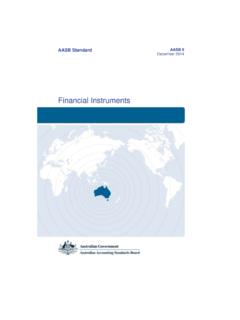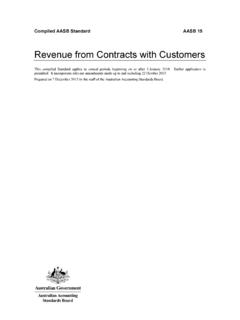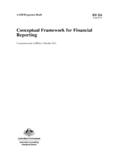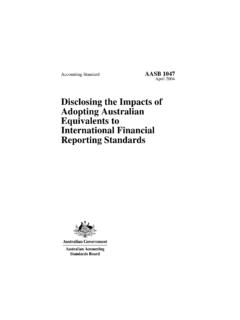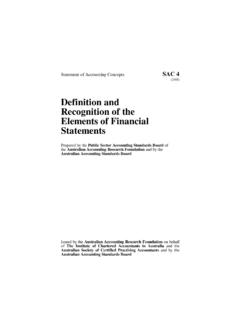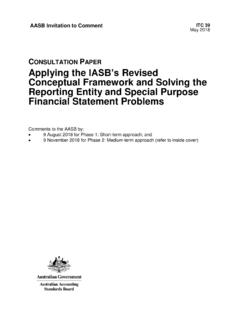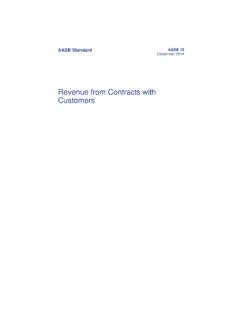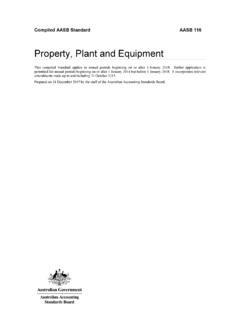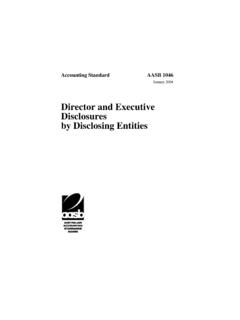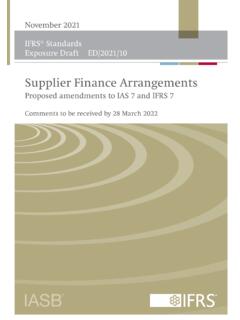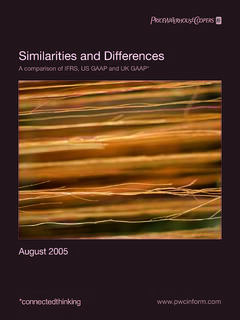Transcription of International Financial Reporting Standard IFRS 9
1 ifrs 9 BC ifrs Foundation International Financial Reporting Standard ifrs 9 Financial Instruments July 2014 BASIS FOR CONCLUSIONS International Financial Reporting standards together with their accompanying documents are issued by the ifrs Foundation. COPYRIGHT Copyright 2014 ifrs Foundation. Reproduction of this extract within Australia in unaltered form (retaining this notice) is permitted for non-commercial use subject to the inclusion of an acknowledgment of the ifrs Foundation s copyright. All other rights reserved. Requests and enquiries concerning reproduction and rights for commercial purposes within Australia or for any purpose outside Australia should be addressed to the ifrs Foundation at CONTENTS fromparagraphBASIS FOR CONCLUSIONS ONIFRS 9 Financial (Chapter 2) AND DERECOGNITION (Chapter 3) (Chapter 4) (Chapter 5) ACCOUNTING (Chapter 6) DATE AND TRANSITION (Chapter 7) OF THE EFFECTS OF ifrs OPINIONSAPPENDIX APrevious dissenting opinionsAPPENDIX BAmendments to the Basis for Conclusions on other StandardsIFRS 9 BASIS FORCONCLUSIONS ifrs Foundation3 Basis for Conclusions onIFRS 9 Financial InstrumentsThis Basis for Conclusions accompanies, but is not part of, ifrs 9 replaced IAS 39 Financial Instruments: Recognition and Measurement.
2 Whenrevised in 2003 IAS 39 was accompanied by a Basis for Conclusions summarising the considerationsof the IASB as constituted at the time, in reaching some of its conclusions in that Standard . ThatBasis for Conclusions was subsequently updated to reflect amendments to the Standard . Forconvenience the IASB has incorporated into its Basis for Conclusions on ifrs 9 material from theBasis for Conclusions on IAS 39 that discusses matters that the IASB has not reconsidered. Thatmaterial is contained in paragraphs denoted by numbers with the prefix BCZ. In those paragraphscross-references to the Standard have been updated accordingly and minor necessary editorialchanges have been made. In 2003 and later some IASB members dissented from the issue of IAS 39and subsequent amendments, and portions of their dissenting opinions relate to requirements thathave been carried forward to ifrs 9.
3 Those dissenting opinions are set out in an appendix after thisBasis for describing the IASB s considerations in reaching its own conclusions on ifrs 9 arenumbered with the prefix This Basis for Conclusions summarises the considerations of the InternationalAccounting standards Board (IASB) when developing ifrs 9 Financial IASB members gave greater weight to some factors than to The IASB has long acknowledged the need to improve the requirements forfinancial Reporting of Financial instruments to enhance the relevance andunderstandability of information about Financial instruments for users offinancial statements. That need became more urgent in the light of the globalfinancial crisis that started in 2007 ( the global Financial crisis ), so the IASB decided to replace IAS 39 Financial Instruments: Recognition and Measurementin itsentirety as expeditiously as possible.
4 To do this the IASB divided the project intoseveral phases. In adopting this approach, the IASB acknowledged thedifficulties that might be created by differences in timing between this projectand others, in particular the project on insurance and ifrs 9 is a new Standard that deals with the accounting for financialinstruments. When developing ifrs 9, the IASB considered the responses to its2009 Exposure DraftFinancial Instruments: Classification and Measurement(the 2009 Classification and Measurement Exposure Draft ). That 2009 Classification and Measurement Exposure Draft contained proposalsfor all items within the scope of IAS 39. However, some respondents said thatthe IASB should finalise its proposals on the classification and measurement offinancial assets while retaining the existing requirements for Financial liabilities(including the requirements for embedded derivatives and the fair value option)until the IASB had more fully considered the issues relating to financialIFRS 9 FINANCIALINSTRUMENTS JULY2014 ifrs Foundation4liabilities.
5 Those respondents pointed out that the IASB had accelerated itsproject on Financial instruments because of the global Financial crisis, whichhad placed more emphasis on issues in the accounting for Financial assets thanfor Financial liabilities. They suggested that the IASB should consider issuesrelated to Financial liabilities more closely before finalising the requirements forclassification and measurement of Financial The IASB noted those concerns and, as a result, in November 2009 it finalised thefirst chapters of ifrs 9, dealing with the classification and measurement offinancial assets. In the IASB s view, requirements for classification andmeasurement are the foundation for a Financial Reporting Standard onaccounting for Financial instruments, and the requirements on associatedmatters (for example, on impairment and hedge accounting) have to reflectthose requirements.
6 In addition, the IASB noted that many of the applicationissues that arose in the global Financial crisis were related to the classificationand measurement of Financial assets in accordance with IAS Thus, Financial liabilities, including derivative liabilities, initially remainedwithin the scope of IAS 39. Taking that course enabled the IASB to obtainfurther feedback on the accounting for Financial liabilities, including how bestto address accounting for changes in own credit Immediately after issuing ifrs 9, the IASB began an extensive outreachprogramme to gather feedback on the classification and measurement offinancial liabilities. The IASB obtained information and views from its FinancialInstruments Working Group (FIWG) and from users of Financial statements,regulators, preparers, auditors and others from a range of industries acrossdifferent geographical regions.
7 The primary messages that the IASB receivedwere that the requirements in IAS 39 for classifying and measuring financialliabilities were generally working well but that the effects of the changes in aliability s credit risk ought not to affect profit or loss unless the liability is heldfor trading. As a result of the feedback received, the IASB decided to retainalmost all of the requirements in IAS 39 for the classification and measurementof Financial liabilities and carry them forward to ifrs 9 (see ). By taking that course, the issue of accounting for the effects of changes in creditrisk does not arise for most liabilities and would remain only in the context offinancial liabilities designated as measured at fair value under the fair valueoption. Thus, in May 2010, the IASB published the Exposure DraftFair ValueOption for Financial Liabilities(the 2010 Own Credit Risk Exposure Draft ), whichproposed that the effects of changes in the credit risk of liabilities designatedunder the fair value option would be presented in other comprehensive IASB considered the responses to the 2010 Own Credit Risk Exposure Draftand finalised the requirements, which were then added to ifrs 9 in In November 2012 the IASB published the Exposure DraftClassification andMeasurement: Limited Amendments to ifrs 9(Proposed amendments to ifrs 9 (2010))(the 2012 Limited Amendments Exposure Draft ).
8 In that Exposure Draft, theIFRS 9 BASIS FORCONCLUSIONS ifrs Foundation5 IASB proposed limited amendments to the classification and measurementrequirements in ifrs 9 for Financial assets with the aims of:(a)considering the interaction between the classification and measurementof Financial assets and the accounting for insurance contract liabilities;(b)addressing specific application questions that had been raised by someinterested parties since ifrs 9 was issued; and(c)seeking to reduce key differences with the US national Standard -setter,the Financial Accounting standards Board s (FASB) tentativeclassification and measurement model for Financial Accordingly, the 2012 Limited Amendments Exposure Draft proposed limitedamendments to clarify the application of the existing classification andmeasurement requirements for Financial assets and to introduce a fair valuethrough other comprehensive income measurement category for particular debtinvestments.
9 Most respondents to the 2012 Limited Amendments ExposureDraft as well as participants in the IASB s outreach programme generallysupported the proposed limited amendments. However, many asked the IASBfor clarifications or additional guidance on particular aspects of the IASB considered the responses in the comment letters and the informationreceived during its outreach activities when it finalised the limited amendmentsin July cost and impairment In October 2008, as part of a joint approach to dealing with the financialreporting issues arising from the global Financial crisis, the IASB and the FASBset up the Financial Crisis Advisory Group (FCAG). The FCAG considered howimprovements in Financial Reporting could help to enhance investor confidencein Financial markets. In its report, published in July 2009, the FCAG identifiedweaknesses in the current accounting standards for Financial instruments andtheir application.
10 Those weaknesses included the delayed recognition of creditlosses on loans (and other Financial instruments) and the complexity of multipleimpairment approaches. One of the FCAG s recommendations was to explorealternatives to the incurred credit loss model that would use more forwardlooking Following a Request for Information that the IASB posted on its website in June2009, the IASB published, in November 2009, the Exposure DraftFinancialInstruments: Amortised Cost and Impairment(the 2009 Impairment Exposure Draft ).Comments received on the 2009 Impairment Exposure Draft and duringoutreach indicated support for the concept of such an impairment model, buthighlighted the operational difficulties of applying In response, the IASB decided to modify the impairment model proposed in the2009 Impairment Exposure Draft to address those operational difficulties whilereplicating the outcomes of that model that it proposed in that Exposure Draftas closely as possible.
